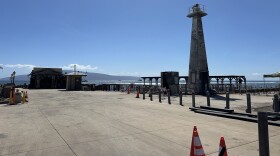Managing Hawai?i's hiking trails is becoming an increasingly complex challenge. Recent news reports of stranded hikers and fatal hiking incidents on our trails have some questioning the effectiveness of unmanaged trail access.
Supplying enough recreation for its residents and the revolving door of tourists is an official task of the state N? Ala Hele program. The trail and access program manages the state's hiking inventory and maintains all state-sanctioned trails across the island chain. HPR reporter Ku?uwehi Hiraishi has more.
LOWE: We’re starting to see a rise in activity almost on all of our trails.
Aaron Lowe oversees the state’s trail and access program called N? Ala Hele which is housed in the Division of Forestry and Wildlife at the state Department of Land and Natural Resources.

LOWE: The challenge is that it’s common to see new trails become popular and a lack of a better word “consumed” by the public and by high numbers or naive visitors and/or in some cases disrespectful residents.
Lowe says not all tourists are naive and not every resident is disrespectful, but when incidents do occur, they can have a lasting impact.
LOWE: What a lot of communities and a lot of private landowners especially small trailhead communities like Kuli?ou?ou on O?ahu they want us to close the trail. These communities have had enough.
While there are challenges to managed access, Lowe warns against the consequences of unmanaged access such as those seen in trailhead communities around illegal hikes such as Sacred Falls or Ha?ik? Stairs.
LOWE: It just opens up a whole other can of worms and burdens on the community sometimes by closing a trail, so how do we work on a win-win solution?

N? Ala Hele has managed public access to hiking trails for nearly 30 years. Established in 1988 to preserve trails from being consumed by development, N? Ala Hele now maintains 76 trails and 42 forestry and access roads statewide.
LOWE: We try to maintain the trails to a certain standard that minimize our liability. So if the signs are in place and the trails in good shape, then you shouldn’t get hurt. And if you do it’s probably because you did something wrong – you didn’t read the sign, or you decided to pick the flower that was hanging off the side of the cliff.
Armed with a statewide team of 10 civil service workers and a $1.2 million budget, N? Ala Hele conducts trail inspections at least four times a year. Lowe says, being proactive with trail maintenance and hiker education is key in managing access. But it also has its limits when it comes to managing an increasing number of users on a limited amount of trails.

LOWE: There are a ton more opportunities and a lot more miles and a lot more trails to choose from in some of our other states but we don’t have that here in Hawai?i, which just adds to the complexity that I think Hawai?i faces.
Lowe says, finding solutions to keeping trails open and eliminating negative impacts to trailhead communities and private landowners will require a lot of creativity and compromise.
LOWE: How do we solve that? Help us come up with answers. Join meetings. Get involved. Volunteer. And let’s try and come to the table and make this work.
To find a trail near you or to learn more about N? Ala Hele, visit HawaiiTrails.org.




